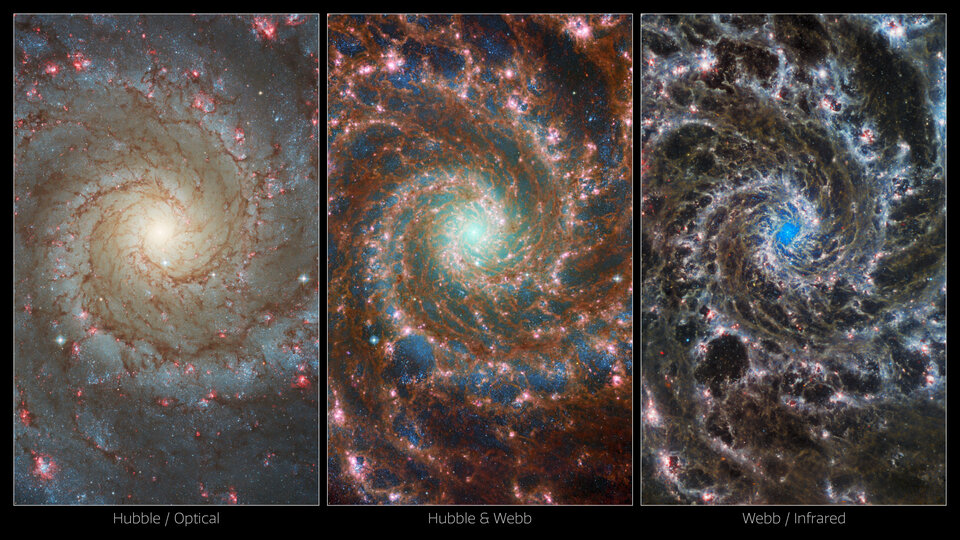
Mother Jones; NASA
Think of Earth as a Kinder Egg, a ball of surprises (plastics) and danger (chemicals known to the state of California to cause cancer) that is reduced to shit by human consumption. Of the many universes, PBS tells me, life can only form in a few—and most of those tolerate but don’t encourage it, the way most people aren’t actively trying to kill you, but also don’t want to hang out. We shouldn’t ask too much.
Still, we one-up the egg time to time: elephants, underwater volcanoes, Indonesian food, Maxwell’s Urban Hang Suite, total eclipses, the movie Friday, the five-inning stretch of Dock Ellis’ 1970 Pittsburgh Pirates acid-trip no-hitter when he thought Richard Nixon was umpire, and, latterly, the James Webb Space Telescope.
The James Webb Space Telescope is the new heavyweight champion of the faraway, the best camera our species has built; Jim, to its friends. Jim makes spectacular the familiar and uncovers new mysteries: it’s already produced NASA’s “deepest and sharpest infrared image” of the universe,” its “most distant known star” (says Space.com), the “first direct image of a planet outside our solar system” (Axios), and, says its own website, “an ‘undiscovered country’ of early galaxies.”

It’s even more impressive given that Jim turns one this Christmas, an age-to-accomplishment ratio to impress even the parents for whom nothing you did was good enough. And—unlike many young people—Jim has not only permanently left the house but is now four times more remote than the moon. I’ll run the numbers.
Weight: 6,170 kilograms, roughly three times the weight of a 1999 Toyota Camry LE.
Length: 69 feet, or three times the length of a 1999 Toyota Camry LE.
Cost: $8.8 billion, about 9,500,000 times the current market value of my 1999 Toyota Camry LE due to cosmetic damage to the passenger-side door.
Value: Revolutionizes astronomy, ushers in new era of space science.
The main event, obviously, is its infrared eyes. I’ll skip the details because I don’t understand them—I think it’s made of iPhone cameras—but you can see how Jim compares to the iconic Hubble Space Telescope, its predecessor. I bet you remember, if you’ve always needed glasses, the first time you saw-saw a tree. Jim is that, spatially:

These big leaps change science, but they also change people. Hubble lit up public interest in space science and the cosmos, with breathless news coverage of spacewalk repairs, as if our worth as a species hinged on our ability to photograph nebulae.
Well, it kind of does. In the age of space billionaires and their cringe-ass fans, Jim reminds us what the stars have always been to human: an orientation, not a destination. Long before anyone thought we could go to space, up was the direction of wonder. Sure, if we don’t destroy ourselves, our kids’ kids’ kids might tour its near reaches. But the point of Yosemite is not that you get to go. The point of a Picasso is not that you can own it. The point of the cosmos is not that you’re in it. If your vision of space exploration is you, on Mars, taking a selfie, you probably also think Wage Theft Jeff’s Fisher Price star-phallus will “increase access to space,” much as hiring more dishwashers at the Waldorf-Astoria technically increases access to luxury hotels.
You won’t be a space tourist because you live in an economy that’s better at directing resources to boutique star cruises than basic infrastructure. Space tourism, unicorn startups, “sustainable” private jets: these are the spots of mold that spell deeper trouble. If your gospel is that most social goods can be private and profitable—maybe with a bit of new tech that’s always five years away—you get disastrous allocative inefficiencies. They accumulate. They metastasize. Next thing you know, you’re fighting the climate crisis by hawking luxury cars. Or “opening space for everyone” by putting shareholders in free fall for the time it takes to pee. That’s systemic market failure. Nothing trickles down in zero G.
That’s not lost on the space-drunk rich. It’s not about humanity; it’s about a few humans. The people who build the vanity rockets would, in a heartbeat, buy the Northern Lights for in-home display. Who do they think will own Luna Colony? Themselves.

Jim is everything they’re not. The JWST feed, publicly funded and freely shared, is there to nourish curiosity. Its mission statement: “We wonder. It’s our nature. How did we get here? Are we alone in the universe? How does the universe work?” Its goal: to “push the boundaries of human knowledge.” It does that, like X-rays or electron microscopes, with new ways of seeing things to see. “When you see Webb go into space,” Jim’s boss, NASA astrophysics chief Eric Smith, said to Smithsonian, “it’s the whole force of human creativity and all kinds of disciplines that push it there.” That is space science. It can yield all the practical, material returns you want, but you know it’s discovery for its own sake because instead of staring at ourselves, or mean-mugging each other, it gets us looking together in the same direction.
Anyway, check this out.

As usual, the staff of Mother Jones is rounding up the heroes and monsters of the past year. Find all of 2022’s here.

















